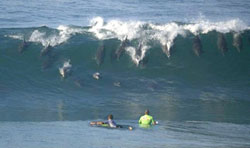You are here: Home › Ecosystems › Coastal Oceans
Coastal Oceans
 Although
the oceans cover 71% of Earth, it is the 7% that comprises the coastal
ocean that most affects, and is most affected by, human activity. The significance
of this narrow strip of ocean—from the outer edge of the continental
shelf to the farthest penetration of salt water up river—is increasing
as more people live near the shore and draw resources from the water. We shape
the coastal ocean through our fishing practices, industrial pollution, habitat
modifications, and agricultural runoff. Coastal oceans affect us through variable
food supplies, water quality, harmful algal blooms, and the buildup of wastewater.
Although
the oceans cover 71% of Earth, it is the 7% that comprises the coastal
ocean that most affects, and is most affected by, human activity. The significance
of this narrow strip of ocean—from the outer edge of the continental
shelf to the farthest penetration of salt water up river—is increasing
as more people live near the shore and draw resources from the water. We shape
the coastal ocean through our fishing practices, industrial pollution, habitat
modifications, and agricultural runoff. Coastal oceans affect us through variable
food supplies, water quality, harmful algal blooms, and the buildup of wastewater.
The coastal ocean is the most biologically productive part of the ocean. Some mechanisms for this delivery are broadly understood but in general, we know very little about why our coasts are so productive. CSCOR studies the coastal ocean through the Climate Change, Ecological Forecasting, Harmful Algal Blooms, Impacts of Land Use, and Hypoxia and Nutrient Pollution. CSCOR/COP is at the forefront of NOAA’s effort to understand the structure and processes that define U.S. coastal oceans.

